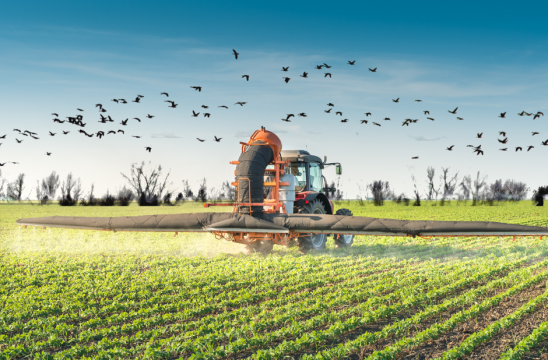19
Nov
Crop Diversity in Commercial Agriculture Decreases Pests and Pesticide Use, Stabilizes Biodiversity

(Beyond Pesticides, November 19, 2020) A new study by researchers at the University of California, Santa Barbara (UCSB) finds that crop diversity in commercial agriculture is just as essential to supporting a stable biological system as plant diversity on non-commercial landscapes. Furthermore, less diverse crop areas lead to higher, more intensive pesticide use, indicating a threat to environmental and human health, as well as food security. This research highlights the need to develop policies that facilitate a decrease in overall pesticide use by helping farmers and global leaders make more knowledgeable decisions about crop area size and diversity to sustain biodiversity. Researchers note, “While [crop] complexity increases stability and reduces high deviations in insecticide use, accounting for crop and farmer-specific characteristics is crucial for statistical inference and sound scientific understanding.
In this study, researchers aim to understand how crop and landscape diversity impacts pest populations, using insecticide use data as a surrogate for pest populations data. Data observations are from Kern County Agricultural Commissioner (CAC), California, over the period 2005 to 2017. Crop data includes crop type, acceptable field size, field and farmer permit number, and active dates for the field. To estimate pesticide use variance, researchers summated annually and peak insecticide uses on crop areas and landscapes. Lastly, researchers estimate the impact of cropland diversity and size on the intensity and variation of insecticide use using a generalized least-squares (GLS) evaluation.
The research finds that more complex/diverse croplands and landscapes boast lower levels of insecticide use, thus lower pest populations. Furthermore, larger, less diverse croplands have higher concentrations of insecticide use with more variation in the type of pesticides used than comparable to smaller, more diverse crop areas. The study’s authors mention, “We find increasing cropland in the landscape and larger fields generally increase the level and variability of pesticides, while crop diversity has the opposite effect.”
Since the 1940s, ecological theory maintains that greater diversity promotes the stability of an ecosystem. However, U.S. commercial agriculture and non-commercial landscapes have become more chemically intensive managed and less diverse. Chemicals, like pesticides, to control many wild plant species on non-commercial landscapes—mainly for aesthetic purposes—not only limits pollinator foraging ground, but also causes harm to pollinators and other animals upon exposure. The implications of commercial, chemical-intensive agriculture are similar but on a much grander scale as farmers more frequently apply pesticide treatments to larger, monoculture crop areas. Perversely, monoculture crops induce biodiversity loss and pollinator. Regions like the Midwest, which boasts vast monoculture grain crops, experience high levels of pesticide contamination in nearby water sources. This circumstance is especially concerning since the current Administration waives the requirement for the multinational company Syngenta to monitor Midwestern waterways for atrazine, a ubiquitous pesticide, contamination.
This study adds to the growing body of scientific research supporting the same conclusion, that larger, monoculture croplands contain higher concentrations of pests, thus higher pesticide use. Large mono-crop can foster specific pests to persist as they have ample of the same food source, thus resulting in greater insecticide use. Small, diverse crop areas can alleviate pest pressure as food sources differ, barring specific pest persistence. The results of the study demonstrate how complex and interconnected pesticide use is regarding cropland size and crop knowledge. Furthermore, the authors suggest global leaders focus on strategies that increase food production while minimizing the impact of pesticides on human health and the environment. Co-author of the study Ashley Larsen, Ph.D., concludes, “Once you introduce insecticides into the study, then it’s not just about diversity and stability in this ecological theory. Now it has implications for environmental impacts and food security. [The] results illustrate that complexity cascades up to affect insect pest control actions and the stability thereof, but that synthesis of observations across crops, farms, or regions must be done with extreme care.”
The study notes various benefits of reducing pesticide use that come with a reduction in pest populations, “Reducing pest abundance and resulting pesticide use yields two types of benefit. First, it reduces the costs of crop losses and pesticide applications, benefits that are likely to be, at least partially, incorporated into farmer decision making. Second, it reduces the negative environmental, ecological, and health impacts of pesticide use, which are benefits largely external to the farmer and thus may be neglected.”
Transitioning from large, monoculture, chemical-intensive commercial farming to small, diverse, organic agriculture can aid in the reduction of pest and pesticide use. Organic agriculture has many health and environmental benefits, which curtail the need for toxic pesticides. Regenerative agriculture revitalizes soil health through organic carbon sequestration while reducing pests and generating higher profits than chemical-intensive agriculture. Learn more about the adverse health and environmental effects chemical-intensive farming poses for various crops and how eating organic produce reduces pesticide exposure. For additional information, see Beyond Pesticides webpage on organic agriculture.
All unattributed positions and opinions in this piece are those of Beyond Pesticides.
Source(s): Science Daily, UCSB










